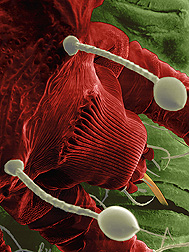This page has been archived and is being provided for reference purposes only. The page is no longer being updated, and therefore, links on the page may be invalid.
Read the magazine story to find out more. |
|
|
Palm Mite is Red Threat on the Horizon
By Linda TokarzMay 18, 2007
A tiny mite is creating a big stir in this hemisphere's tropics.
Scientists with the Agricultural Research Service (ARS) and the Animal and Plant Health Inspection Service (APHIS) have joined a multinational effort to stop the red palm mite, an invasive pest that rides the wind and, until now, was mainly known for attacking coconut palms in the Eastern Hemisphere's tropical and subtropical regions.
According to Ronald Ochoa, a mite expert at the ARS Systematic Entomology Laboratory in Beltsville, Md., the red palm mite has been found in the Caribbean region, including on U.S. soil in Puerto Rico and St. Thomas.
The fast spread of this pest, which causes serious leaf damage, constitutes the biggest mite explosion ever observed in the Americas, according to Ochoa. He added that, in Trinidad, he and colleagues estimated there were 30 to 100 million mites per palm.
At stake may be more than just the health of sectors of the ornamental plants industry and the palm trees that are synonymous with the tropical lifestyle. On Dominica, the mite has attacked banana plants, and a grower in Trinidad indicated that he anticipates a 50 percent loss in coconut production on his property, according to Ochoa.
The red palm mite, Raoiella indica, was first described in 1924 in India, and identified in the Western Hemisphere three years ago on Martinique. Its calling cards include yellow-spotted or totally discolored palm leaves, and reddish-brown areas signaling mite clusters.
USDA scientists have learned a great deal about the mite since being alerted to its presence by concerned officials representing several Caribbean nations. It's hoped that their studies will help lead to biological and chemical controls and a means of monitoring for new hosts of the mite.
Read more about this research in the May/June 2007 issue of Agricultural Research magazine.
ARS and APHIS are part of the U.S. Department of Agriculture (USDA). ARS is USDA's chief in-house scientific research agency.

